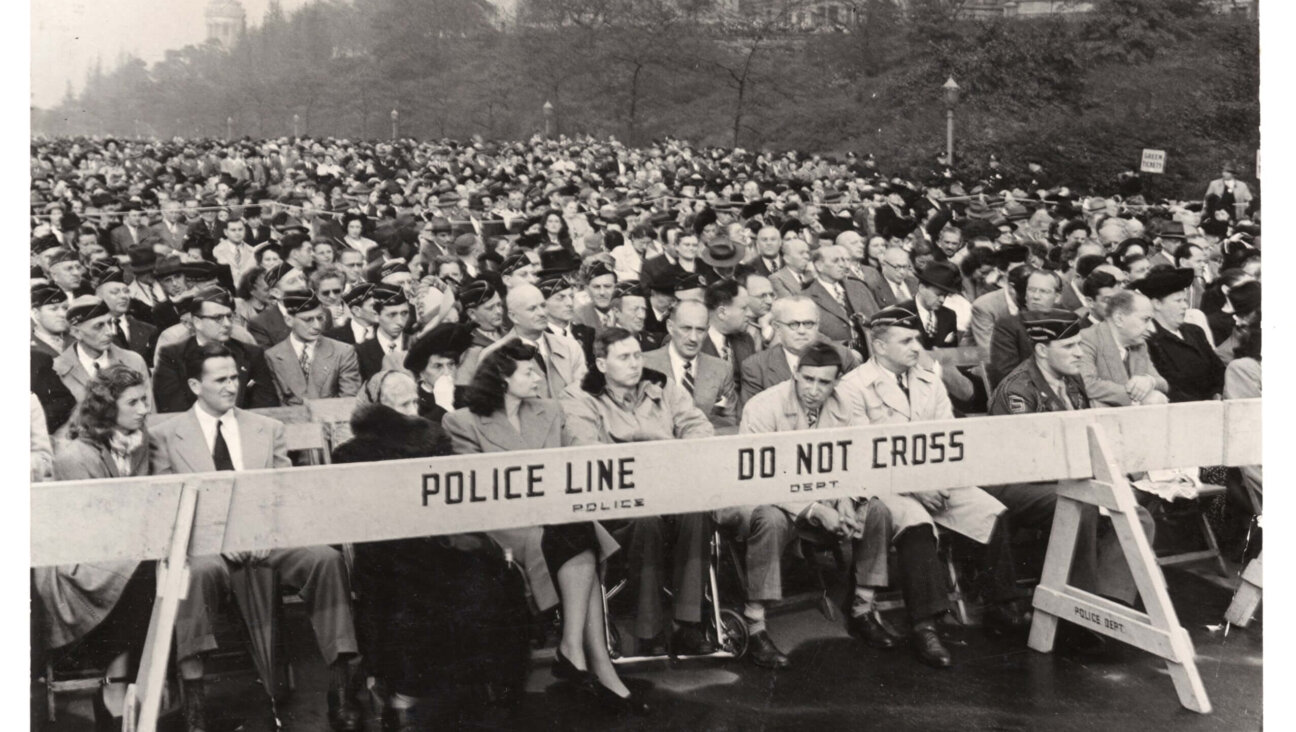Whither Utopia?
Picture Imperfect: Utopian Thought For an Anti-Utopian Age
By Russell Jacoby
Columbia University Press, 240 pages, $24.95.
* * *|
Utopianism has gotten a bad rap over the past 50 years. The desire to secure happiness through the basic transformation of social institutions has been blamed for most of the past century’s carnage, from Hitler’s dream of a 1,000-year Reich to Pol Pot’s murderous campaign to return Cambodia to agrarian purity. But we are supposed to be safe from its blandishments now. Communism is dead. And realism has finally won.
As it turns out, anti-utopianism was delivered an unanticipated body blow by the fall of the Eastern bloc, and it suddenly lost its polemical edge. In his most recent book, “Picture Imperfect: Utopian Thought for an Anti-Utopian Age,” historian and cultural critic Russell Jacoby argues that we have to get rid of our prejudice against utopian thought. He makes a strong plea for utopianism, and it turns out to be a specifically Jewish one at that.
The conventional brief against utopianism claims that modern utopians (and utopianism is a particularly modern pursuit) misunderstand either our nature or our proper ends. Traditional conservatives flatly mistrust the whole notion of perfectibility and are suspicious of the airy confections of human reason. They argue that the social norms and institutions that have been developed over the centuries serve as our first defense against our intractable lusts and our inevitable hates. Traditional liberals, along with their neoconservative progeny, have a somewhat milder view of human endeavor. However, they share the conservatives’ fear of unintended consequences, arguing that happiness is best left to the accidents of individual decision and cannot be attained through social planning. Both sides accuse utopians of indulging in dangerous fantasies and claim that the history of fascism and state socialism has vindicated their judgment.
But as Jacoby points out, the anti-utopians have rigged their case. Nationalism and ethnic hatred, not utopian aspiration, launched Europe into the bloody fiasco of World War I at the start of the 20th century; nationalism and ethnic hatred led to the slaughters in Serbia, Croatia, Kosovo and Rwanda at the century’s end. Jacoby seems to assume, rightly enough, that utopianism must be universal in its reach and goals. Nationalism, by definition, is particularistic, and so by definition it cannot be properly utopian. Fascism fails the basic test of utopianism because it is concerned solely with the fate of individual peoples and states. Stalinism could not even live up to its own boilerplate claims, and therefore it never really could fit the utopian bill. In the end, it is not possible to make stick the charges that utopianism is of a piece with totalitarianism or that utopianism, and not nationalism or colonialism, was the cause of the 20th century’s greatest evils.
Jacoby argues that true utopianism comes in two basic flavors. There are the dreary “blueprint” utopias that most college students encounter in introductory philosophy and political theory classes. These texts, which range from Plato’s “Republic” to Skinner’s “Walden Two,” are famously boring because they insist on enumerating all the details of their ideal states; they become obsessed with the size of dormitories and the length of coats.
The other flavor, somewhat less familiar, is the negative utopianism. This is supplied by Martin Buber, by Buber’s friend, mystical anarchist Gustav Landauer, and by the “Frankfurt School” — Max Horkheimer, Theodor Adorno, Walter Benjamin, Herbert Marcuse and, more distantly, Ernst Bloch. Negative utopians did not try to find the exact dimensions of their desired future. Rather, they criticized the present in the name of its most cherished and tenuous beliefs — freedom, equality and justice — as well as its most fragile promises: the satisfaction of material and spiritual needs. They set these norms and promises as the proper goal of all political — actually all human — endeavor. While their thought could move quickly from critique to mysticism, and while it could shade into satire easily, it never succumbed to absolute despair. On the contrary, the negative utopians sought to pan gold from disappointment, to find veins of hope in even the most barren ground.
Jacoby’s heart lies with this second group. To his mind, there always has been something fishy about the blueprint utopians. In their drive to nail down the details of a fulfilled and fulfilling future, they have seemed much too willing to sacrifice freedom to authoritarianism. But the same is not true of the negative utopians.
There is an interesting twist to this argument: Jacoby notes that Jews wrote almost none of the “blueprint” utopias. (Herzl’s Zionist fantasy, “Altneuland,” stands out as the most telling exception to this rule.) On the other hand, almost all the negative utopians whom Jacoby cites were central European Jews born between 1870 and 1905. Is there something intrinsically Jewish about negative utopianism? (Jacoby never asks if there is anything essentially goyish about the other kind.)
Actually, Judaism boasts a long tradition of positive — even “blueprint” — utopianism. We find it in the discussions of, speculations on and yearnings for the messianic age. The negative utopians rarely draw on this tradition directly. Interestingly enough, nor do they refer to the rabbis’ ban on descriptions of the Olam Habah, the World to Come. They seek their inspiration elsewhere. Jacoby takes seriously — perhaps too much so — the suggestion put forward by Horkheimer and Adorno that negative utopianism is at heart Jewish because it adheres strictly to the Second Commandment, the proscription on graven images.
Jacoby suggests that the negative utopians’ refusal to depict political redemption stems from a deep, almost atavistic, mistrust of the visual image that he attributes to Judaism in all its stages. Recent scholarship has cast some doubt on the 19th-century cliché that Jews always have been the sworn enemies of the visual and that Judaism is by nature iconoclastic, even iconophobic. So we do not have to trace the negative utopians’ fierceness toward the image back to Sinai; we can attribute it to the fact that these thinkers were the attentive children of an assimilated, German-speaking liberal Judaism that prided itself on its rationalism and on its capacity for abstraction. They might have reacted strongly against liberal Judaism’s emphasis on the absolute ineffability of God, and against its displacement of faith by ethics, but they were defined to their core by these beliefs and these displacements. More importantly, they viewed the entire Jewish heritage through the lens of liberal Judaism. Negative utopianism does not reflect an eternal Jewish essence, but rather stands as one of the finer flowers of modern Judaism. (Gershom Scholem, great scholar of kabbalah and connoisseur of Jewish heterodoxy, saw the Frankfurt School as one of the final heresies of German Jewry. And there is no reason to suppose he was wrong.)
It is no coincidence that this flower began to bloom in Central Europe at the beginning of the 20th century. Negative utopianism expresses the longing for apocalypse, which marked the whole generation that came of age around the time of World War I. But it also does more. It gives voice to the searing disappointment felt by modernizing Jews when the Austrian and German Empires refused to live up to the terms of emancipation. And, as we know too well, this refusal became catastrophic during the Third Reich. The Holocaust did not change the negative utopians’ minds about anything; it merely reinforced their yearning for a better world as well as their abiding negativity. If liberal Judaism can be described as the attempt to make Judaism fit a German-speaking modernity, negative utopianism signaled the failure of this attempt. It analyzed this failure, explained it and damned it all at once.
If the negative utopians were so much a product of their time and place, why do we need them now? According to Jacoby, utopianism must be marshaled to counter “the dwindling force of the modern imagination” — that is, our apparently passive acceptance of things as they are. And Jacoby values the iconoclasm of the negative utopians because “they resist the modern seduction of images.”
You also could make the case for negative utopianism somewhat differently. The negative utopians were committed to modernity while being skeptical about technology, individualism and capitalism. They had good reason for this skepticism. And “postmodernity” notwithstanding, their skepticism and their good reason still hold.
What is more, they can help guide us in our present, somewhat perplexing moment. Our current anti-utopianism was in no small way shaped by Central and Eastern European Jewish intellectuals such as Leo Strauss, Karl Popper, Isaiah Berlin and Hannah Arendt. Their ideas, sometimes shorn of their sophistication and nuance, have become the various building blocks of contemporary neoconservatism. But for all the “realism” attributed to the Jewish neocons, we are confronted by the fact that they have been the architects of the Bush administration’s speculative policies in the Middle East. If one looks at the plans and the justification for the invasion and occupation of Iraq, one cannot help but think that they seem less the products of a steely-eyed realpolitik than of a lazy (or perhaps overconfident) utopianism — and a “blueprint” utopianism at that. It could well be that reports of utopia’s death were a little premature.
Therefore Jacoby makes an important point: Once it has been cleansed of its Cold War trappings and its inaccuracies, anti-utopianism proves to be a rather slim reed on which to base politics. Strong political movements are born of outrage or of its concomitant, hope. As we have seen in the past quarter-century both here and abroad, a joyless reformism rarely wins elections or builds enduring constituencies. As “blueprint” utopianism and its pale but powerful imitations continue to confront us, negative utopianism — a modern and particularly Jewish mode of thought — might turn out to be the order of the day.
David Kaufmann teaches English at George Mason University.

I hope you appreciated this article. Before you go, I’d like to ask you to please support the Forward’s award-winning journalism this Passover.
In this age of misinformation, our work is needed like never before. We report on the news that matters most to American Jews, driven by truth, not ideology.
At a time when newsrooms are closing or cutting back, the Forward has removed its paywall. That means for the first time in our 126-year history, Forward journalism is free to everyone, everywhere. With an ongoing war, rising antisemitism, and a flood of disinformation that may affect the upcoming election, we believe that free and open access to Jewish journalism is imperative.
Readers like you make it all possible. Right now, we’re in the middle of our Passover Pledge Drive and we need 500 people to step up and make a gift to sustain our trustworthy, independent journalism.
Make a gift of any size and become a Forward member today. You’ll support our mission to tell the American Jewish story fully and fairly.
— Rachel Fishman Feddersen, Publisher and CEO
Join our mission to tell the Jewish story fully and fairly.
Our Goal: 500 gifts during our Passover Pledge Drive!























